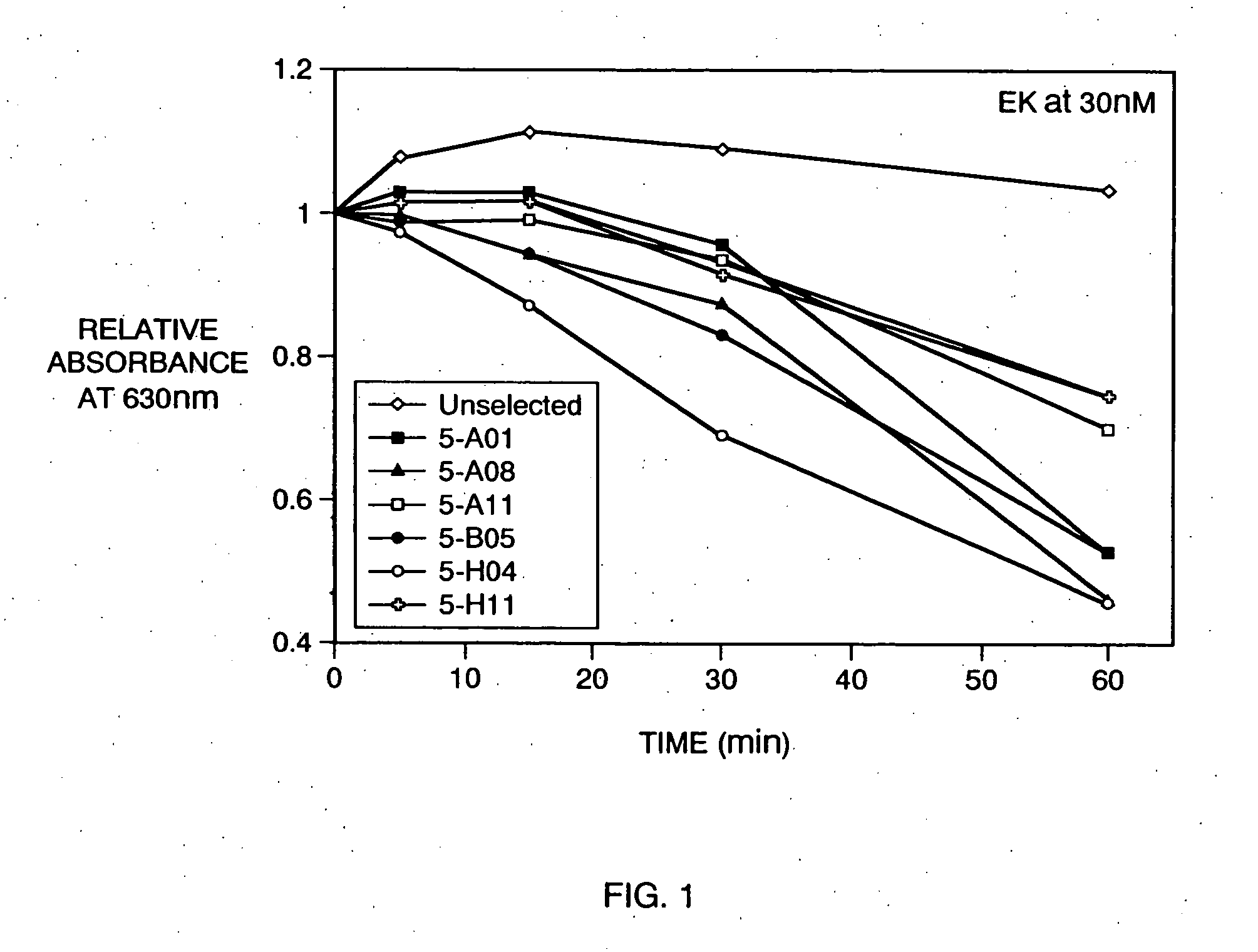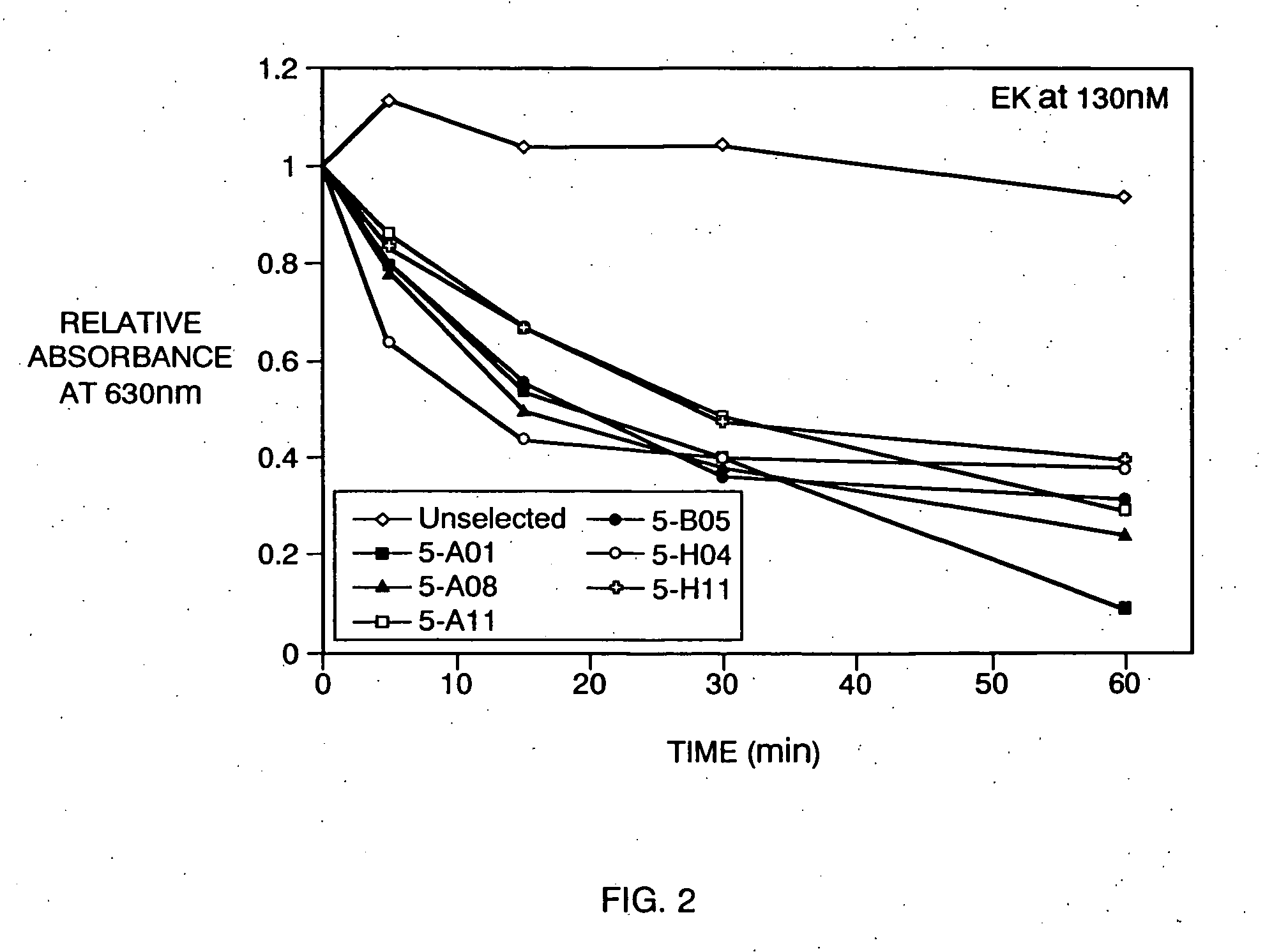[0015] Preferred enterokinase recognition sequences of the present invention exhibit not only a high binding specificity for the enterokinase
enzyme but also rapid cleavage by the enzyme at a predetermined site within the cleavage recognition domain. Such sequences are useful for the rapid purification of almost any protein of interest expressed from a host
cell.
[0016] The present invention also provides
DNA sequences encoding an enterokinase-cleavable fusion protein comprising a novel enterokinase recognition sequence of the present invention fused to a protein of interest. Additionally, the
DNA construct optionally includes a
nucleotide sequence encoding a ligand recognition sequence which specifically recognizes and binds to a ligand binding partner, such as, for instance, a
streptavidin binding peptide sequence for binding a
streptavidin substrate, providing a means for ready capture of the enterokinase-cleavable protein of interest, which can be released by cleavage at the enterokinase recognition sequence to yield pure protein of interest.
[0018] Also provided by the current invention are methods for the isolation and purification of a protein of interest present as one domain of a larger fusion protein. The protein of interest can be easily cleaved from the rest of the fusion protein, preferably by capture of the fusion protein on a
solid substrate and subsequent treatment of the immobilized complex with enterokinase. In one embodiment, the fusion protein is secreted from the host
cell into a culture medium. The culture medium is passed over a column which contains a ligand binding partner, such as, for instance,
streptavidin or
biotin, immobilized on a substrate. The ligand recognition sequence of the fusion protein forms a binding complex with the ligand binding partner thereby immobilizing or capturing the fusion protein on the column. Enterokinase is then added to the column to cleave the protein of interest from the captured fusion complex and the protein of interest is released from the fusion protein complex bound to the ligand binding partner. The purified protein of interest is collected in the flow-through supernatant.
[0029] In another embodiment the present invention provides a fusion protein comprising a protein of interest fused to a ligand recognition sequence via the novel enterokinase recognition sequences of the present invention. The protein of interest can be any protein or fragment thereof capable of expression as
a domain in a fusion construct. The fusion construct can be expressed as an intercellular protein in, for instance, E. coli, and isolated by disruption of the cells and removal of the fusion construct from the cellular supernatant. Alternatively, the fusion construct can include
a peptide signal sequence effective for signaling
secretion from the host cell producing the fusion protein. This will preclude the necessity to lyse the E. coli or other host cells to release the expressed fusion protein and thereby eliminates the need for an additional
protein purification step specifically to remove unwanted
cellular debris.
Signal peptide sequences that are known to facilitate
secretion of peptides expressed in E. coli into the culture medium include Pel B, bla, and phoA.
[0030] The ligand recognition sequence domain of the fusion construct can be any sequence which recognizes or exhibits an affinity for a binding partner such as, for instance, streptavidin. Preferred recognition sequences include the streptavidin binding sequence His-Pro-Gln-Phe (SEQ ID NO:6) and the modified streptavidin binding sequences Cys-His-Pro-Gln-Phe-Cys (SEQ ID NO:5) and Cys-His-Pro-Gln-Phe-Cys-Ser-Trp-Arg (SEQ ID NO:7). Additional preferred recognition sequences include the streptavidin binding sequences Trp-His-Pro-Gln-Phe-Ser-Ser (SEQ ID NO:210) and Pro-Cys-His-Pro-Gln-Phe-Pro-Arg-Cys-Tyr (SEQ ID NO:211). The addition of the cysteines to the modified streptavidin binding sequence makes the domain somewhat more like a protein (in that the domain obtains a 3-dimensional structure), the addition of
tryptophan makes the binding sequence a better
UV absorber (therefore making it easier to
assay), and the addition of
arginine aids
solubility. In a preferred embodiment the streptavidin ligand recognition sequence or the modified streptavidin ligand recognition sequence is fused at the amino-terminal end of the novel enterokinase recognition sequences disclosed in the present application. Several such sequences can be added in tandem to provide multimeric immobilization sites.
[0031] In another embodiment, the present invention provides
a DNA expression vector, for transformation of a host cell, coding for a fusion protein comprising a protein of interest fused at either the NH2-terminus or COOH-terminus to an enterokinase recognition sequence of the present invention. The enterokinase recognition sequence may additionally be fused to a ligand recognition sequence which binds to a particular ligand and can be used to capture the ligand recognition sequence and any protein of interest attached to it, to a
solid substrate. Preferably the ligand recognition sequence is positioned relative to the enterokinase recognition sequence and the protein of interest so that upon capture on a
solid substrate, treatment of the fusion construct with enterokinase enzyme will release the protein of interest from the construct. Additional
DNA sequences included in the
expression vector may include a
promoter to facilitate expression of the fusion protein in the selected host cell and preferably also a
signal sequence to facilitate
secretion of the fusion protein into the culture medium prior to the purification step.
 Login to View More
Login to View More 

